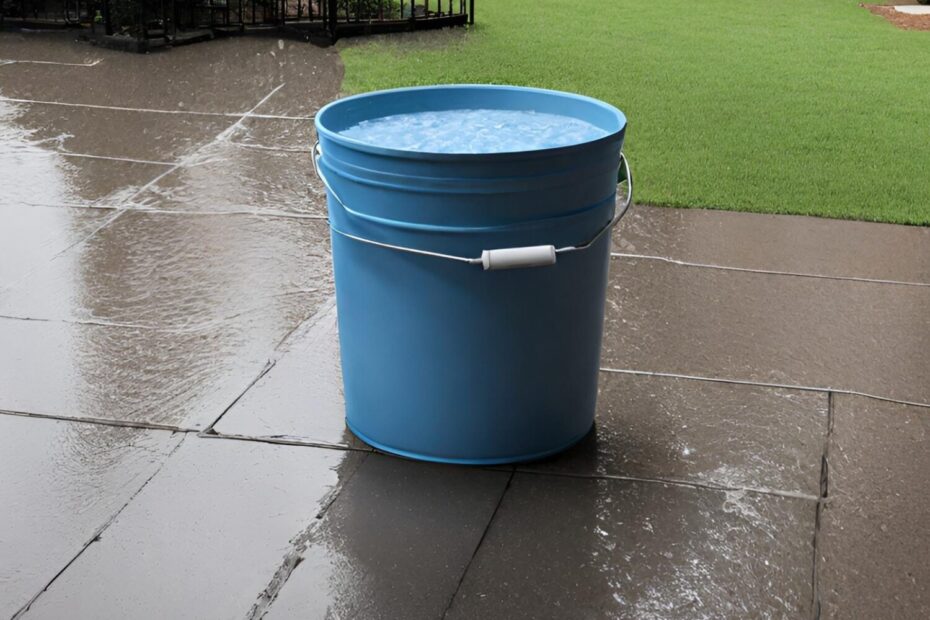[ad_1]
Some of the links in this post may contain affiliate links for your convenience. As an Amazon Associate, I may earn a small commission from qualifying purchases without any increase in price to you.
Most families in populated areas rely on city water supplies for clean water. In a disaster, though, that water source may be disrupted. Choose one of these simple yet effective ways to collect rainwater in urban and suburban areas and make sure you have clean, drinkable water in an emergency.

Back in the 2010’s, I lived in a single-family home in a suburb of Orange County, California. We were solidly in a drought that had been plaguing the West for several years. While I had no danger of completely running out of water, there was definitely a financial incentive to conserve. By collecting the runoff from my daily shower and filling my toilet tank with it, my flushes didn’t use fresh potable water. While this a good use of gray water, we also need alternative methods to collect water if city water supplies are disrupted. In a long-term emergency, you’ll want to stretch your existing water storage as long as possible, so having ways like this to supplement is smart.
What’s your goal?
With most urban and suburban dwellings hooked up to a water system and sewer, the urban or suburban resident is in a good non-disaster water situation. Even so, many people seek to capture rainwater because we hate to see waste and not just food waste. Your goal might be simple, such as collecting and directing gutter downspout discharge into a garden, or a survival-related project of keeping a couple of barrels full of water, “just in case.” Your goal and your circumstances determine your set-up.
Collection Setups
The urban and suburban environment is unique due to lot size and close proximity to other structures. These limitations directly affect your ability to harvest rain at your home location; an option discussed below is to find a location in the community where you can harvest a limited amount of rain in a public place, and bring home in your car.
From simple to more complicated, here are some urban and suburban rainwater collector scenarios:
- Rooftop with 5-gallon buckets: In an apartment building or other location with a flat roof or patio, set out buckets overnight to collect rain or snow, manually carry to your residence. Use a tarp to expand the surface area of this small rain water collector.
- Kiddie pool on a small lot: Hard plastic or inflatable pool, 4’-6’ diameter, pump or scoop out the water. Requires supervision to prevent kids from drowning. Read this post for more preparedness uses for kiddie pools.
- Large barrel connected to a gutter downspout: 40–85-gallon plastic barrel semi-permanently connected. Some have a spigot that attaches to a garden hose for use.
- Mobile collection: A hard or flexible plastic water tank in your vehicle is filled by a tarp or plastic sheeting laid in a depression on the ground to collect the rain. A battery-powered water pump moves the water into the tank.
Pro Tip
Prioritize water purification by using portable water filters or purification tablets after collecting rainwater. This extra step ensures that the harvested water is safe and drinkable during emergencies.
Other Considerations
Restrictions
It’s important to recognize the realistic limitations of rainwater collection in the urban/suburban environment. Much more than rural rainwater harvesting, your potential project may be subject to state, county, or local requirements regulating what you can and can’t do; for example, the City of Los Angeles, California has specific requirements for harvesting rainwater. While they encourage collecting rain from your roof, you are not allowed to use it for your consumption, and they supply free “Do Not Drink” stickers for rain barrels.
Additionally, the L.A. program specifies setback distances from the residence and property lines. While these requirements are strict, their web site has specific guidance and videos to help consumers set up their home project. Check your local regulations before proceeding.
Weather
Your climate, defined as the long-term weather pattern in your area, will affect your ability to have a successful rain harvest and create the best setup. People in Seattle, known to have a fairly rainy climate, will be able to count on rain every few days; a smaller project can be successful because of the repetitive storms. Those in Phoenix will have rare rain except during their monsoon season, which may require a larger investment in storage to be worthwhile.
Mastering the details of weather predictions will allow you to be ready to maximize your harvest. The most useful prediction tool used by the National Weather Service is the QPF (Quantitative Precipitation Forecast) which predicts the amount of rain expected in a specific area over a specific time period, such as an hour. Knowing when a bunch of rain is set to arrive allows you to check your collection setup beforehand.
Frequently Asked Questions
The amount varies, but optimizing collection setups based on available space and local regulations can help maximize your harvest. This rainwater harvesting calculator can help you determine the possible volume from your roof.
Yes, check local regulations as some areas may have guidelines on collection methods, storage, and usage of harvested rainwater.
Related Content


Final Thoughts
In populated areas, families usually depend on city water, but disasters can disrupt this source. These methods are ways for city and suburban families to collect rainwater, ensuring access to clean and drinkable water during emergencies, and making stored water last longer.
Tell us about your rainwater collection systems in the comments!
[ad_2]
Source link


